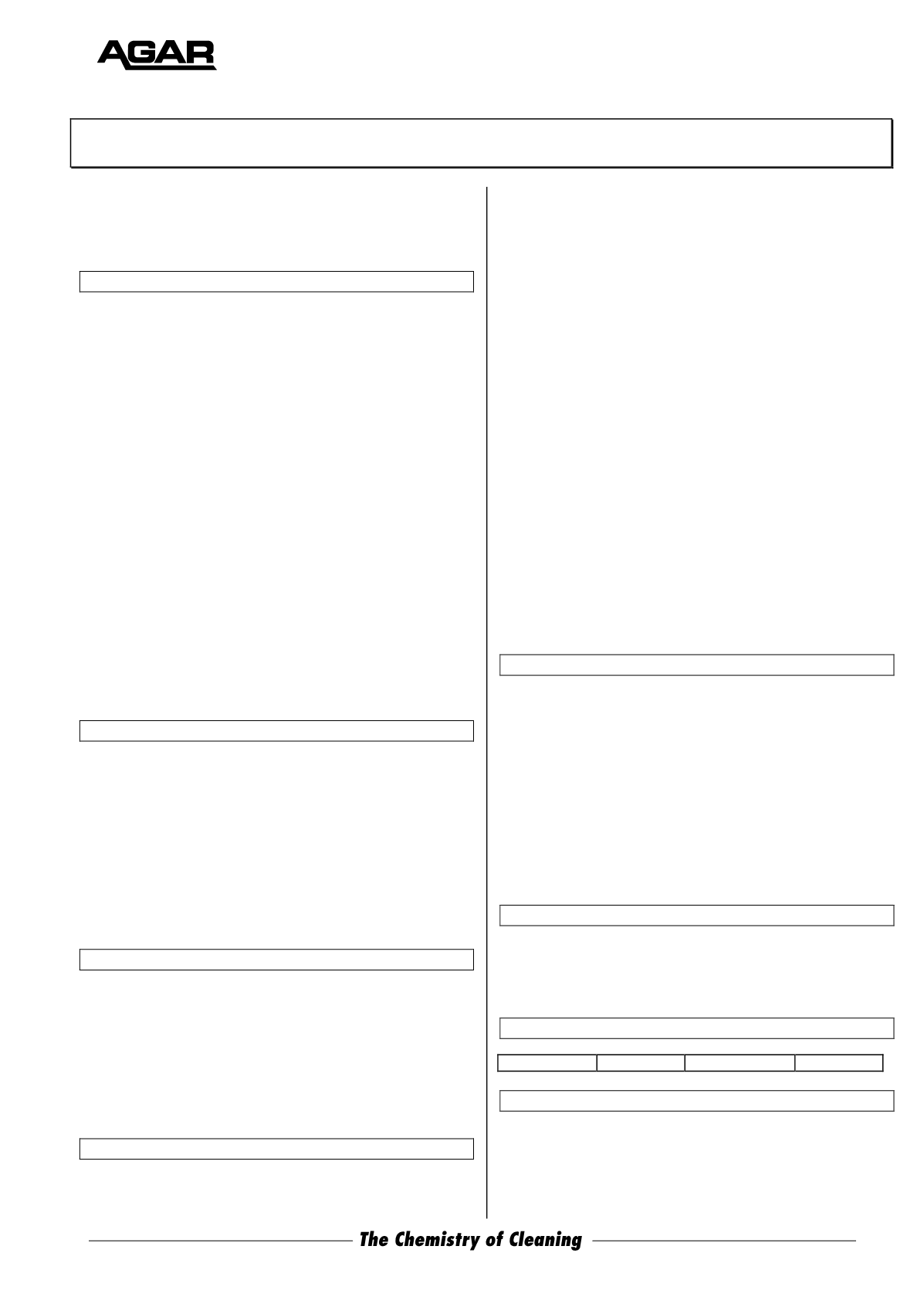

ABN 80 004 726 890
MADE IN AUSTRALIA
Safety Data Sheet
Issued: April 14, 2011
Page 2 of 3
LAUNDRY BRIGHTENER
Incompatibility (Materials to avoid for purposes of transport,
handling and storage only): Avoid storage with foodstuffs,
combustible or organics. Class 5.1 Oxidizing substances shall
not be stored with any other Dangerous Goods.
8 EXPOSURE CONTROLS / PERSONAL PROTECTION
Exposure Standards: None assigned for mixture. Data for
principal ingredients only :
Safe Work TWA: 1 ppm, 1.4 mg/m³
Safe Work STEL: none established
TLV (ACGIH): 1 ppm, 1.4 mg/m³ - 8hr TWA
PEL (OSHA): 1 ppm, 1.4 mg/m³ (90%) - 8hr TWA
Engineering Controls: Mechanical ventilation: not required under
normal conditions, but local exhaust ventilation should be
used to control any air contaminants to within the Exposure
Standards.
Personal Protection:
Gloves - Wear rubber, neoprene or vinyl gloves.
Note: Resistance of glove materials can vary. Evaluate
resistance under conditions of use and maintain PPE
carefully.
Eye protection – Splash-proof goggles and full face-shield
should be worn.
Respiratory – If inhalation risk exists, a suitable, NIOSH-
approved cartridge type Respirator (ABEK2P3)should be
worn.
Other – Protective overalls are desirable. An eyewash unit
should be available. Do NOT wear leather boots as they
can catch fire within minutes of contact with peroxide.
9 PHYSICAL AND CHEMICAL PROPERTIES
Appearance: Clear, colourless liquid
Odour: None
pH = 2.5 – 3.5
Vapour Pressure: Same as water
Vapour Density: N/K
Boiling Point: Approx. 105
°
C
Freezing Point: < 0
°
C
Solubility in water: Infinitely miscible
Specific Gravity: 1.10
Evaporation rate: As water
% Volatile by vol: 100%
10 STABILITY AND REACTIVITY
Unstable if heated or contaminated.
Do not keep product in metal containers or mix with metal
stirrer.
Not combustible but decomposition of product will increase the
explosive limits and burning rate of flammable vapours.
Hazardous polymerization: None.
11 TOXICOLOGICAL INFORMATION
Health Effects:
Acute -
Swallowed: Swallowing can lead to bleeding of the mucosa in
the mouth, oesophagus and stomach. The rapid releasing of
oxygen can cause distension and bleeding of the mucosa in
the stomach and lead to severe damage of the internal
organs, especially in the event of greater intake of product..
Eye: Harmful. Eye contact may result in extreme irritation up to
cauterisation. Can cause severe conjunctivitis, corneal
damage or irreversible eye damage. Symptoms may occur
with delay.
Skin: Harmful. Principal route of exposure is usually by skin
contact. Irritating to the skin and capable of causing skin
burns. Contact will result in whitening and irritation.
Increasing contact will lead to local erythema or extreme
irritation up to blistering.
Inhalation: Irritating to the respiratory system. Inhalation of
vapours in confined spaces may cause irritation to mucous
membranes and possible pulmonary edema. Symptoms may
occur with delay after any exposure.
Health Effects –
Chronic:
Repeated or prolonged skin contact
may cause swelling, blistering or dermatitis.
Toxicity data: None available for mixture. Data is for principal
ingredient:
Oral LD50 (rat) = 801 mg/kg, 35% solution.
Inhalation 8hr LC50 (rat) = > 2000 ppm, 90% solution.
Skin absorption LD50 (rabbit) = 700 mg/kg, 90% solution.
(Note: this data is from published information. Agar Cleaning
Systems does not carry out animal tests).
12 ECOLOGICAL INFORMATION
Ecotoxicity: 100% product
Fish Ictalurus Punctatus LC50 96hr: 37.4 mg/L (Literature)
Fish Ictalurus Punctatus LC0 96hr: 17 mg/L (Literature)
Fish Oncorhyncus Mykiss LC50 24hr: 31.3 mg/L (Literature)
Daphnia Magna EC50 24hr: 7.7 mg/L (Literature)
Daphnia Magna EC0 24hr: 3.8 mg/L
Persistence and degradability:
50% degradation within approximately 20 hours: medium: air.
The product can be degraded by abiotic (chemical or photolytic)
processes. Under ambient conditions, quick hydrolysis,
reduction or decomposition occurs.
Mobility: No information ia available.
Advice: Avoid contaminating drains, sewers orwaterways.
13 DISPOSAL CONSIDERATIONS
Dilute small quantities of product to at least 0.5% (i.e., 1 in 200)
before disposal to sewer. Dispose of larger quantities in
accordance with all local, State and Federal Regulations.
14 TRANSPORT INFORMATION
UN No.: 2014 Class: 5.1, 8 Packg.Group: II Hazchem: 2P
15 REGULATORY INFORMATION
Poisons Schedule Number: Schedule 6.
Product must be stored, maintained and used in accordance
with the relevant regulations.
Please turn to Page 3.


















